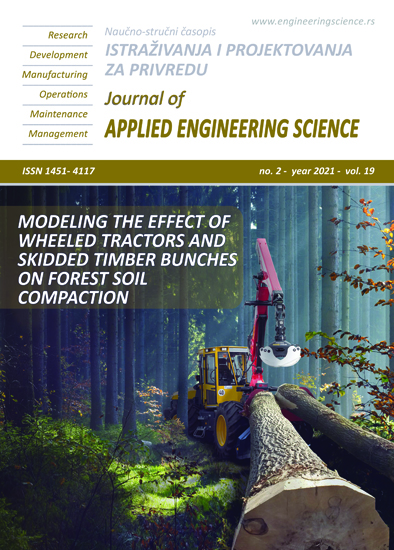BEHAVIOUR OF THERMOSTONE BLOCKS WITH AND WITHOUT CEMENT MORTAR PLASTERING EXPOSED TO HIGH TEMPERATURES
Abstract
Autoclaved aerated concrete (Called Thermostone in Iraq) is one of the popular building materials that are used in various purposes in construction industries. It is factory-made material that can be moulded into blocks which can be used in framework buildings. However, these buildings are under the risk of fire since it has different cusses such as arson and electrical short circuit. It is important to find ways to improve counter such phenomenon. Therefore the objective of this paper is investigating the fire resistance performance of Thermostone with and without plastering. Five different samples were used for the test, four of them were covered with different types of plastering. Three tests were employed for this study: Compressive, absorption, and density test. For all tests, the samples were exposed to elevated temperatures from 250 °C to 900 °C. It was shown that plastered samples have demonstrated a higher fire resistance and lower absorption rate than non-plastered ones.
References
M.S. Al-Shaikhli, W.H. Wan Badaruzzaman, S. Baharom, A.W. Al-Zand, The two-way flexural performance of the PSSDB floor system with infill material, Journal of Constructional Steel Research 138 (2017) 79-92.
F.C. Campbell, Structural composite material, ASM International, United States of America, 2010.
Ö. Kırca, Ancient binding materials, mortars and concrete technology: history and durability aspects, Structural Analysis of Historical Constructions Taylor & Francis Group, Mersin, Turkey, 2005, pp. 87-94.
Internet Archive Wayback Machine, The History of AAC, 2010. http://www.hebel.co.nz/about/hebel.
A.A.H. Abdulameer, Types of Failure in Cellular Concrete Blocks (Thermostone), Kufa Journal of Engineering 3(2) (2012) 101-114.
R.J.A. Sldozian, Effect of Waste Thermostone as an Aggregate in Concrete Containing Nano-SiO2, International Journal of Scientific & Engineering Research 5(7) (2014) 1199-1204.
T.M. Borhan, Effect of using recycled lightweight aggregate on the properties of concrete, Journal of Babylon University 23(2) (2015) 453-464.
S.H. Awad, E.A. Al-Majeed, M. Al-Issawi, Glazing and Coloring of Cellular Concrete Blocks, Journal of Babylon University 23(3) (2015) 678-688.
E.A.A.-M. Ibrahim, D.H. Hameed, EFFECT OF GLASS WASTE ON PROPERTIES OF CELLULAR CONCRETE WASTE POWDER, Iraqi journal of mechanical and material engineering 17(1) (2017) 76-86.
A.R. Hasan, K.H. Hamzah, Study the Possibility of Recycling Damaged Thermostone in, International Journal of Engineering & Technology 7(4.36) (2018) 281-285.
ISQ No. 1441 (2013), "Thermostone tests", Baghdad, Iraq, 2013.
ISQ No. 5, "Properties of Ordinary Portland Cement", Baghdad, Iraq, 1984.
ISQ No. 45, "Properties of Natural Aggregate Resources" Baghdad, Iraq, 1984.
ASTM C 567-05a, "Standard Test Method for Determining Density of Structural Lightweight Concrete", 2005.
ASTM C 109, "Standard Test Method for Compressive Strength of Hydraulic Cement Mortars", ASTM International, PA, USA, 2005.
ASTM C 1403, "Standard Test Method for Rate of Water Absorption of Masonry Mortars" ASTM International PA, USA, 2005.
K. Sakr, E. El-Hakim, Effect of high temperature or fire on heavy weight concrete properties, Cement and concrete research 35(3) (2005) 590-596.
V.R. Kodur, M.A. Sultan, Effect of temperature on thermal properties of high-strength concrete, Journal of materials in civil engineering 15(2) (2003) 101-107.
R. Sarshar, G. Khoury, Material and environmental factors influencing the compressive strength of unsealed cement paste and concrete at high temperatures, Magazine of concrete research 45(162) (1993) 51-61.
M. Shirkavand, R. Baggott, Effects of superplasticizer on workability and flexural strength of autoclaved calcium silicates, Cement and concrete research 25(7) (1995) 1512-1522.
P.D. Morley, R. Royles, Response of the bond in reinforced concrete to high temperatures, Magazine of Concrete Research 35(123) (1983) 67-74.
M.K. Umran, Fire flame exposure effect on some mechanical properties of concrete, Civil engineering Department,, Babylon University, Babylon, Iraq, 2002.
A.S. Awad, Effect of fire flame exposure on flexural behaviour and shear strength of reinforced NSC and HPC beam, Babylon University, Babylon, Iraq, 2008.
G.T.G. Mohamedbhai, Effect of exposure time and rates of heating and cooling on residual strength of heated concrete, Magazine of Concrete Research 38(136) (1986) 151-158.
Y. Ungkoon, C. Sittipunt, P. Namprakai, W. Jetipattaranat, K.-S. Kim, T. Charinpanitkul, Analysis of microstructure and properties of autoclaved aerated concrete wall construction materials, Journal of Industrial and Engineering Chemistry 13(7) (2007) 1103-1108.

